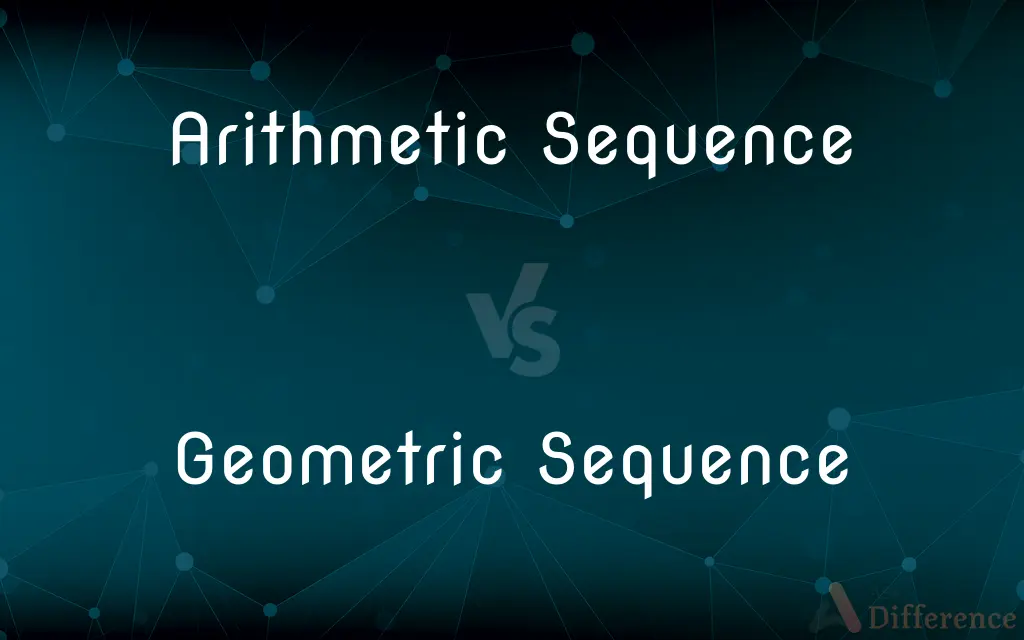Arithmetic Sequence vs. Geometric Sequence — What's the Difference?
Edited by Tayyaba Rehman — By Fiza Rafique — Published on December 15, 2023
An Arithmetic Sequence has a constant difference between terms, while a Geometric Sequence has a constant ratio between terms.

Difference Between Arithmetic Sequence and Geometric Sequence
Table of Contents
ADVERTISEMENT
Key Differences
In an Arithmetic Sequence, each term is found by adding a constant difference to the previous term. Conversely, in a Geometric Sequence, terms are derived by multiplying the previous term by a constant ratio.
For any Arithmetic Sequence, subtracting consecutive terms always yields the same result. In contrast, dividing consecutive terms of a Geometric Sequence consistently provides the same ratio.
When graphed, an Arithmetic Sequence typically generates a straight line, demonstrating its linear nature. On the other hand, a Geometric Sequence, being exponential in nature, produces a curve when plotted.
An Arithmetic Sequence is ideal for representing situations with consistent increases or decreases. Meanwhile, a Geometric Sequence effectively represents scenarios involving growth rates, such as compound interest.
Real-world applications of Arithmetic Sequences can include salary increments over years, while Geometric Sequences might depict the growth of a population or the depreciation of an asset.
ADVERTISEMENT
Comparison Chart
Pattern of Progression
Constant difference
Constant ratio
Formula (n^th term)
A + (n-1) * d
A * r^(n-1)
Representation
Linear
Exponential
Example
2, 5, 8, 11, ...
3, 6, 12, 24, ...
Real-world Application
Salary increments
Population growth
Compare with Definitions
Arithmetic Sequence
A progression where each term is derived by adding a constant.
The sequence 5, 10, 15,... shows an arithmetic sequence with an addition of 5.
Geometric Sequence
Terms are the product of a consistent ratio.
The population doubling yearly forms a geometric sequence.
Arithmetic Sequence
Linear progression of numbers.
The sequence 1, 3, 5, 7,... is an arithmetic sequence increasing by 2.
Geometric Sequence
Progression where each term multiplies by a fixed factor.
In the sequence 5, 15, 45,..., each term is thrice the previous term.
Arithmetic Sequence
A sequence with a fixed difference between consecutive terms.
The sequence 4, 7, 10, 13,... is an arithmetic sequence with a difference of 3.
Geometric Sequence
A sequence with a constant ratio between terms.
The sequence 2, 4, 8, 16,... is a geometric sequence with a ratio of 2.
Arithmetic Sequence
A list of numbers with uniform intervals.
The temperatures over days rising by 2°F daily showcases an arithmetic sequence.
Geometric Sequence
Exponential sequence of numbers.
The sequence 3, 9, 27, 81,... is geometric, with each term multiplying by 3.
Arithmetic Sequence
Terms have consistent differences.
In the arithmetic sequence 6, 11, 16,..., the difference is consistently 5.
Geometric Sequence
A series where ratio remains constant between consecutive terms.
In the geometric sequence 4, 12, 36,..., the ratio is consistently 3.
Common Curiosities
Is it possible for the ratio in a Geometric Sequence to be less than 1?
Yes, this represents a decreasing geometric sequence.
How is the next term in a Geometric Sequence found?
By multiplying the previous term by a constant ratio.
Can the difference in an Arithmetic Sequence be negative?
Yes, it results in a decreasing sequence.
What determines the next term in an Arithmetic Sequence?
The constant difference added to the previous term.
Do real-world scenarios often model Arithmetic Sequences?
Yes, scenarios with consistent increments, like salary raises.
Can the terms in an Arithmetic Sequence multiply?
No, terms are found by addition or subtraction.
Can an Arithmetic Sequence ever be exponential?
No, it's always linear due to its constant difference.
How does the graph of a Geometric Sequence typically appear?
Exponential, either increasing or decreasing.
Which sequence, Arithmetic or Geometric, best describes compound interest?
Compound interest is best modeled by a geometric sequence due to its growth rate.
Can a Geometric Sequence have a zero term?
If zero appears, all subsequent terms will be zero.
Share Your Discovery

Previous Comparison
Ionic Covalent vs. Metallic Bonds
Next Comparison
Venomous Snakes vs. Non-venomous SnakesAuthor Spotlight
Written by
Fiza RafiqueFiza Rafique is a skilled content writer at AskDifference.com, where she meticulously refines and enhances written pieces. Drawing from her vast editorial expertise, Fiza ensures clarity, accuracy, and precision in every article. Passionate about language, she continually seeks to elevate the quality of content for readers worldwide.
Edited by
Tayyaba RehmanTayyaba Rehman is a distinguished writer, currently serving as a primary contributor to askdifference.com. As a researcher in semantics and etymology, Tayyaba's passion for the complexity of languages and their distinctions has found a perfect home on the platform. Tayyaba delves into the intricacies of language, distinguishing between commonly confused words and phrases, thereby providing clarity for readers worldwide.
















































